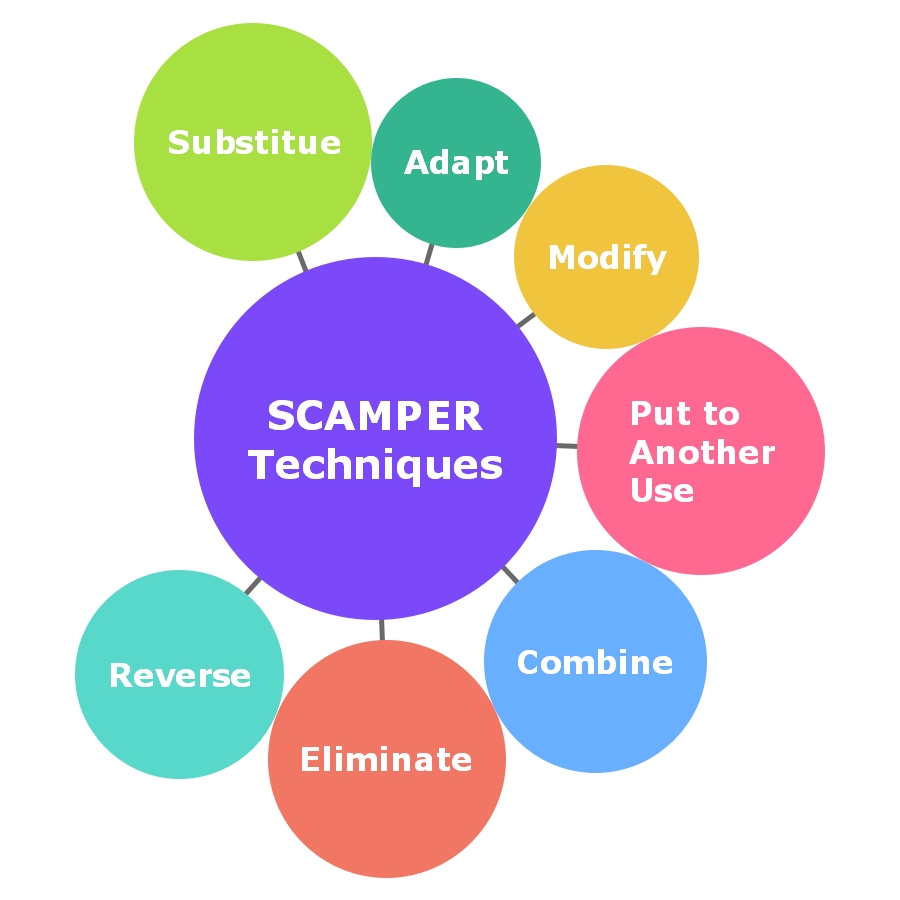The SCAMPER method, developed by Alex Osborn, the pioneer of brainstorming, and popularized by Bob Eberle, provides a practical framework for generating new ideas by revisiting and reimagining existing elements. The acronym SCAMPER represents different actions to take:
- S – Substitute: What would happen if you replace one element with another?
- C – Combine: How can you combine different ideas or elements to create something new?
- A – Adjust: Can you modify a part of the idea to enhance its efficiency or relevance?
- M – Modify: In what ways can you change the appearance, form, or nature of the idea?
- P – Put to another use: What can be extracted or simplified while maintaining the integrity of the idea?
- E – Eliminate: Is there something you can remove to simplify the idea?
- R – Rearrange: How can you reorganize or restructure the idea to achieve new results?
Application in Entrepreneurship
Entrepreneurs continually face challenges that demand innovative solutions, and the SCAMPER method offers a practical framework for systematically exploring these solutions.
- Stimulating Creativity The SCAMPER method plays a role in stimulating entrepreneurs’ creativity by encouraging lateral thinking. By substituting, combining, adjusting, modifying, putting to another use, eliminating, and rearranging, entrepreneurs can discover unique perspectives that might escape a more traditional approach.
- Solving Complex Problems In the entrepreneurial context, complex obstacles are commonplace. The SCAMPER method provides entrepreneurs with a structured tool to address these problems systematically. By following this approach, they can systematically identify innovative solutions, transforming challenges into growth opportunities.
- Fostering Continuous Innovation Innovation is not a one-time event but rather a continuous process. By integrating the SCAMPER method into their thinking process, entrepreneurs can maintain a constant flow of innovative ideas. This allows them to stay at the forefront of their industry by anticipating emerging trends and adjusting their approach accordingly.
Practical Example: SCAMPER in the Technology Industry
Consider a technology company looking to improve its flagship product, a smartphone.
- Substitute: Replace the material of the casing with a lighter polymer.
- Combine: Integrate augmented reality technology with the existing camera.
- Adjust: Modify the phone’s ergonomics for better grip.
- Modify: Redesign the user interface for a more intuitive experience.
- Put to another use: Remove less-used features to simplify the product.
- Eliminate: Eliminate physical buttons in favor of touch controls.
- Rearrange: Rethink the layout of internal components for more efficiency.
Practical Tips and Tools
- Collaborative Brainstorming Encourage the participation of different people during brainstorming sessions. Multiple perspectives can enrich the process and generate more varied ideas. Use online brainstorming tools like Miro, Trello, or built-in brainstorming features in project management platforms to facilitate collaboration.
- Mind Mapping Use mind maps to visually organize generated ideas. Tools like MindMeister or XMind can help create interactive mind maps that illustrate the connections between different ideas.
- SWOT Analysis Complement the SCAMPER method with a SWOT analysis (Strengths, Weaknesses, Opportunities, Threats) to evaluate the feasibility and relevance of generated ideas. Identify strengths to reinforce, weaknesses to address, opportunities to exploit, and threats to anticipate.
- Rapid Testing and Prototyping Quickly materialize some ideas into simple prototypes. Rapid tests will help evaluate the viability of concepts and allow for quick adjustments.
- Seek External Inspiration Explore different industries, foreign markets, or entirely different fields to find sources of inspiration. Innovative ideas can often be adapted and successfully applied in different contexts.
- Role Rotation If working in a team, rotate facilitator roles during brainstorming sessions. This allows each team member to contribute actively and bring varied perspectives.
- Use Constraints Introduce artificial constraints to stimulate creativity. For example, limit the time allocated to each step of the SCAMPER method or ask participants to generate ideas based on specific constraints.



